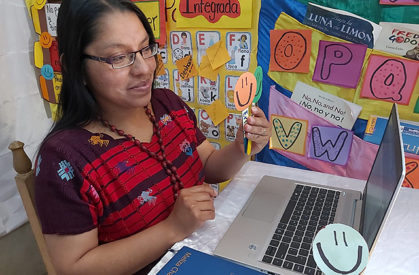
For all of us, the last year has been equal parts exhausting and frightening. In 2020, a global pandemic shook many of us personally and professionally, and we witnessed collective change at a dizzying pace. As is often the case in times of great turbulence, we’ve all learned a few things about ourselves and our way of doing things.
Child Aid is no different. Our education mission withstood a grave threat when schools across Guatemala were proactively shuttered in March 2020. The school closings spun our organization into a momentary tailspin. How do you deliver a literacy program to elementary-age children when the classrooms are empty and children are kept at home?
We knew our Child Aid staff members in Guatemala were talented and creative, but this crisis really demonstrated how outstanding they are in meeting the challenges head-on with strategic thinking and energy. And from their year-long efforts to continue our literacy offerings – as well as meet the blossoming food crisis that came to Guatemala on the heels of the pandemic – Child Aid has not only continued our long tradition of literacy work, but we’ve been able to dramatically improve our program, too. We are deeply grateful.
Here are some of the ways we’ve improved the Child Aid program due to lessons learned during the pandemic:
IMPROVEMENT ONE: Launching Online Teacher Training Workshops
Child Aid believes in a face-to-face learning environment. After all, there’s nothing like sitting next to a teacher when they have one of those incredible lightbulb moments. But the crisis forced us to embrace technology in a way we hadn’t tried before (or even thought possible). As a result, Child Aid sought out technological solutions that enhance our program. We are working to improve our efficiency by 25 percent by 2022, effectively shortening our program by up to a year while adding even more valuable content to our program. We can’t wait to get back into classrooms, but when we do our program will be even stronger.

HOW WE DID IT: Using technology such as Zoom and WhatsApp, we’ve shortened our teacher training workshop formats and designed some content into easily digestible and shareable videos that workshop participants can watch before training begins. There’s no substitute for in-person teacher trainings, but adding in supplementary and easily accessed digital learning materials streamlines our approach and makes our coaching even more effective. Teachers find the online format easy to attend (few geographical barriers) and easy to schedule, so these online offerings fit seamlessly into our overall literacy program.
IMPROVEMENT TWO: Providing Resources for Teaching During Covid-19
While the kids are away, the teachers keep … learning? Yes! Child Aid’s virtual coaching programs gives teachers a chance to practice teaching techniques without the chaos of a full classroom.
HOW WE DID IT: Although our inability to enter classrooms was a profound limitation on our literacy program delivery, it gave us an opportunity to see how much we could accomplish while working with a teacher for an hour or more without the chaos of a classroom. From surveying our teachers, we realized they were not receiving much support on how to meet their students’ needs during the pandemic. Since students did not have access to technology, teachers were creating student-facing materials to send home every week based on materials from the Guatemalan government. But these materials were dense and hard to understand for students and their families. Child Aid used our coaching sessions with educators to help teachers develop materials that were student-friendly and also kept teachers focused on developing appropriate content for their students. The coaching sessions were popular with teachers because they provided direct support to teachers and their specific students’ needs.
IMPROVEMENT THREE: Reaching Kids Directly Through TV and Radio
Child Aid can reach students directly through television and radio programming, so we did!

HOW WE DID IT: Child Aid staff put together television and radio programming that aired on local stations and brought educational programming directly to children where they live. Our staff made the programming participatory, with call-in opportunities for children to respond to the messaging. Weekly radio broadcasts were especially successful as more households have access to and listen often to radio programming. The response from kids, families, and communities was overwhelmingly positive; they asked that we continue the program in 2021.
IMPROVEMENT FOUR: Implementing Grade-Level Workshops
Online training means we can accommodate the needs of teachers better!
HOW WE DID IT: Virtual delivery of workshops meant that Child Aid was not limited by the difficult geography of Guatemala and could bring teachers from multiple schools together even when those schools were too distant to have made in person workshops possible. Soon, our staff began grouping teachers into workshops by grade level and not school, allowing teachers from all over Guatemala who teach the same grade to meet, learn together and share strategies. This was extremely successful and much appreciated by teachers. We plan to take this approach in some of our workshops even when we are not limited by the pandemic.
IMPROVEMENT FIVE: Breaking through Geographic Barriers
Geography in Guatemala has always been a limiting factor in our growth … or so we thought!
HOW WE DID IT: Travel in Guatemala is challenging. If it isn’t a stomach-lurching mountain range standing in your way, then it’s a washed out road or the threat of a flash flood. Child Aid always knew that for our organization to grow, we’d have to open up multiple geographically distant offices. So we did. Slowly. But this crisis forced our organization to continue our work while remaining socially distant. Our biggest concern? Could we maintain the strong cultural bond and execute our program well if we only saw each other in person infrequently? We’ve been delighted at the staff cohesion and creativity that has emerged. Child Aid now feels very confident about a more rapid rate of growth than we previously thought possible.